Bike Tour on Ice
February - April 1992
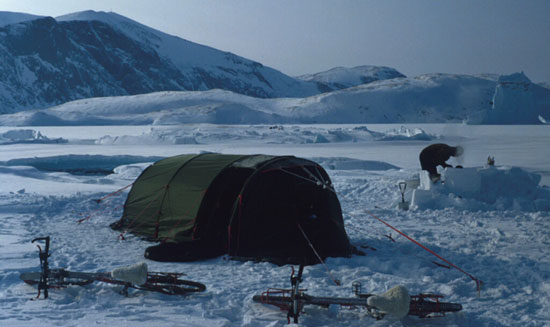
| The island of Greenland is one of the most extreme
places on earth one can choose for cycling. Yes - it is possible... |
|
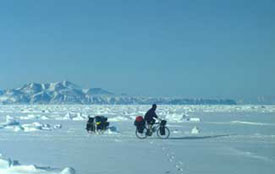 |
A few hours ago,
the outside temperature in Copenhagen was +16°C, and now the thermometer
shows -47°C!! The batteries of the electronic thermometer still
work, but the LCD display froze black. A 63 degree temperature difference...
It is said that the first night in the arctic is the worst... Biking
in Greenland? How is it possible in a country without a road system?
|
| During my first biking expedition in South Greenland in Summer 1989, this was a real problem. It seemed that Greenland was not suitable for bike touring. All the traffic routes were on water. One should be riding on water - the frozen sea in winter. From this idea, after two and one half years of preparation, the second Greenland expedition developed, together with my friend Gottfried Debove. | |
In February 1992 we stared in Upernavik (northwest
Greenland) and rode along the coast from one village to the next.
The outside temperatures were so low, that the natives (Inuits) were
careful not to work so hard to be sweating. The reason for this was
that they wore clothing out of fur, which are not ventilated. During
our expedition the Greenland winter conditions were a real challeng
for out clothing. If we rode too fast, we were sweating wet -
and water vapor under these conditions is dangerous. |
 |
Since vapor would still be freezing
within the clothes, very quickly we could have been covered with an
ice layer and we would have frozen terribly upon stopping. Another
problem was oxygen supply when riding fast. Due to the low temperature
we had to ride with masks, but air only penetrates slowly and they
covered with ice quickly. So, our tour necessarily became slowly and
relaxing... And we had time - from mid February to mid of May. Our
record was 65 km on one day. Yes, and the one riding slowly makes
less mistakes and saves energy which we had to carry with us as calories... Our diet consisted of 5.5 Mcal per person per day. That was equivalent to 1.2 kg of dry food per person per day. Since we could only carry food for three weeks on the bike, we made depots. A lot of gear and most of the food was sent by ship to Upernavik and Uummannaq. In both villages our boxes were stored and before each new tour we stocked up with food and cooking gas and deposited our waste of the previous tour. |
|
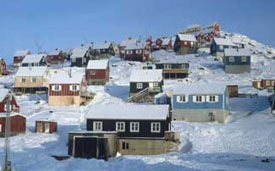 |
It is amazing that on actually can eat that much calories per day! But preparing it, is a lot of work... It takes time before the best mix for müsli was found, energy bars were baken and a mix of fruits and nuts was ready. But not only biking made it necessary to eat so much calories, especially the low temperatures made one eat an additional 2 Mcal. |
| Of course the bike material had to be of best quality,
since there was no help out on the ice. When the cable housings simply
break without reason, the grease becomes solid, the fuel for the cooker
precipitates, and rum in the bottle freezes, then it is really cold.
In such situations one has to rely completely on the right material
- it may be important for survival. We were unable to test most of the
material at home, since cold rooms only reach -30°C. So, we had
to find out there what's good... And: our bike chain Rohloff
S-L-T-99 was perfect! Those who think there are no sharp edges on frozen sea, will be surprised. In fall the ice plates freeze together and produce sharp edges. And with the enormous weight of the bikes snake bites could easily have been the rule. Luckily we had no flat tire within the three months: during our preparations we had practiced mending a flat tire while wearing thick gloves - it is impossible! With thin gloves on, it works, but then one is exposed to the extreme temperatures, especially when there is wind! One day I was cleaning my stove with only thin gloves on, I froze six fingers until they were black. I was lucky that the flesh was able to regenerate within four weeks, but with extreme pain. I will not display any pictures of it here... |
|
| Apart from biking we also did some hiking and fishing and had some interesting contacts to the natives. During our winter tour, we only visited remote villages and were very often invited to eat with the natives. We even were invited to birthday parties of children as "special guests". It seemed that the locals then had enough to talk about for the rest of the year, and we were able to learn about their way of life. People are very friendly, and for a hunters, this hospitality can mean survival, if the distances between the villages are large. | |
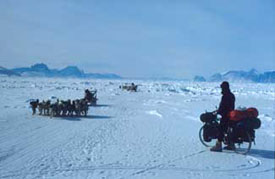 |
However, the natives never understood, why we preferred to live in our tent, instead of moving into a heated house. Heated houses nowadays became the standard for the Inuit. For us it always was a pain to stand the heat of a house for so long, and then eat hot tea and meat or fish. We always were happy to be back in the dry coldness of the arctic air. We were so much adapted to the extreme cold temperatures, that we used the warm periods end of April with temperatures of -8°C to cycle without shirts... |
| At temperatures warmer than -10°C the snow on the ice became sticky, and soon, from 10th of April on (sun did not set anymore) we cycled from 2o'clock at night to 11o'clock at noon. During the day we slept in our down-sleeping bags (comfort at -45°C). | |
The expedition was a full success for us. We
made valuable experiences and were able to admire the beauty
of the arctic landscapes. Last not least, we learnt a lot about the
life and the culture of the Inuit. Although today they have guns,
gas stoves, and nylon fishing lines, they are the only people who
can survive in the extreme climate of the arctic. |
 |
All the waste we accumulated during
our three months stay, we sent back in a box (80cm x 40cm x 60cm).
We have learnt a lot and didn't want to miss the experiences of the
often difficult planning and cycling in extreme coldness.
Yes - we want to go back. In winter, of course! |
|
Greenland
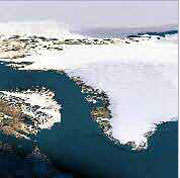
The area of Greenland is 2,175,000 km². Only 16 % are free of ice, the remaining 84% are covered by a huge glacier. The 55,000 inhabitants consist of about 47,000 Inuits and 8,000 Europeans.
There are regular flights to Greenland from Kevlavik (Iceland) and Copenhagen (Denmark).
More information at the Danish Polar Center